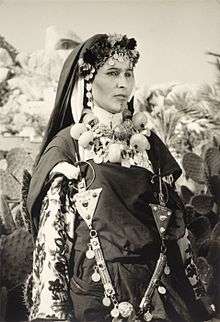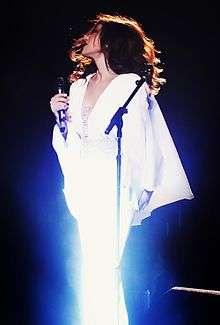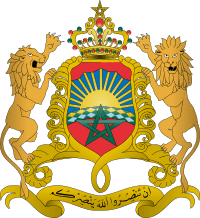Women in Morocco
 A Moroccan women skilled in the ancient art of hand spinning fibers | |
| Gender Inequality Index[1] | |
|---|---|
| Value | 0.460 (2013) |
| Rank | 92nd out of 152 |
| Maternal mortality (per 100,000) | 100 (2010) |
| Women in parliament | 11.0% (2013) |
| Females over 25 with secondary education | 20.1% (2012) |
| Women in labour force | 43.0% (2012) |
| Global Gender Gap Index[2] | |
| Value | 0.5845 (2012) |
| Rank | 129th out of 144 |
The history of women in Morocco includes their lives from before, during, and after the arrival of Islam in the northwestern African country of Morocco. In 622 AC, as Islam arrived in Morocco, the women of Morocco received three basic rights under the Muslims' religion: the right to live, the right to be honored and to be respected as a mother, and the right to own business and be able to work. From the 1940s until the Moroccan declaration of independence from the tutelage of France in 1956, Moroccan women lived in family units that are "enclosed households" or harem, wherein extended families live as one unit together and where women are secluded and require permission from the men before leaving a household that is protected by a gate keeper. In addition, during that time, married women were treated better than women who were divorced. The hierarchy and importance of women were further categorized according to age and status in the family and community. Among their activities during that period were performing household chores, embroidery, and crafts, attending Koranic schools, and going to a Moroccan bathhouse known as the hammam. The tradition of the harem lifestyle for women gradually ended upon Morocco's independence from France in 1956.[3]
After Morocco's independence from France, Moroccan women were able to start going to schools that don't focus only on teaching religion, but also sciences and other subjects. Upon the institution of the legal code known as Mudawana in 2004, Moroccan women obtained the rights to divorce their husbands, to child custody, to child support, and to own and inherit property.[3]
While Morocco's current borders and entity as a nation state were not recognized until 1956 following independence from France, women there have played a significant role in its conception, which spans several centuries. From their roles of relaying oral traditions and stories, to forging the foundation of important institutions, to their involvement in resisting colonialism, and holding positions of power following the establishment of the Moroccan state, women were and continue play significant roles in Morocco.
Amazigh women in Morocco
Prior to the spread of Islam into Morocco, which brought along with it the Arab conquest, Morocco was part of a region inhabited mostly by a non-Arab Amazigh population.[4] Various Amazigh tribes during the 4th, 5th, and 6th century were noted to have been matrilineal, such as the Tuareg tribes of North Africa.[5] As such, Amazigh women were noted to have taken on significant roles in local communities. This was especially evident through the figure of Kahina, who was a noted Amazigh female military leader who fought against the Arab and Muslim expansion into North Africa.

Amazigh women have had a lasting position in Moroccan folklore, a position that predates the Arab and Muslim conquest of the Maghreb region. It is believed that the tale of Aisha Qandisha has existed since at least the 7th century.[6] There are several variations of Aisha Qandisha’s name, among which include Lalla Aicha and Aicha Hamdouchia. Stemming from the pre-Islamic era of Morocco, Aisha Qandisha is said to have been a female demon that takes the shape of multiple beings, including a half-goat.[7] Aicha Qandisha, unlike other demons in Moroccan folklore, appears mostly in men’s dreams and is said to make a man impotent. Such folklore remains widely popular in Morocco today.
Establishment of Islamic institutions (680-900)
Following the Arab and Muslim expansion into the Maghreb region, women took on significant roles in the institutional foundation of landmarks that continue to function today. Fatima al-Fihri, for example, is credited for founding the University of al-Karaouine in 859, the “world's first academic degree-granting institution of higher education” in Fes, Morocco.[8] Fatima’s sister, Mariam al-Fihri, also founded the al-Andalus Mosque in Fes.[9]
Imperial expansion into North Africa, and Colonialism (1600-1956)
As part of a broader French imperialist project that justified the colonization of Morocco and the Maghreb region in general, European narratives on Moroccan women were fixated on Orientalist images. Dominant narratives described Moroccan women as docile, oppressed, and in need of being saved. Consequently, Moroccan women’s experience of life under colonialism was a result of multiple intersections of power and patriarchy. For example, following a growing trend of French land expropriation, which drove rural Moroccan families out of their homes and land, many Moroccan women migrated to the urban areas in search of economic opportunity, especially in Casablanca.[10] Upon migrating to Casablanca, many Moroccan women were forced into prostitution, namely due to their lack of formal identification documents—a policy that the French instituted.
Women in anti-colonial resistance
Just as Moroccan women were subject to a gendered form of colonialism, their resistance was gendered as well. The oral traditions of Moroccan women were a unique form of disseminating stories of resistance, oftentimes inspired by existing Islamic oral traditions of female warriors who fought in early Islamic history, such as the stories of Hind and Sukayna.[11] Moroccan women, especially those involved in the armed resistance primarily in the northern Rif region, adopted their own experiences of fighting against colonialism to existing frameworks of oral traditions that address women in war. The storytelling of these events played a significant role in shaping memories and conceptualizing post-colonial identities among women.
In addition to the oral traditions of women involved in armed resistance, a role that mostly lower class women took up, upper class Moroccan women were heavily involved in the nationalist politics of resisting colonialism. The Istiqlal Party was the primary mobilizing political force in Morocco that rallied against French colonial rule. The party included the participation of various elite Moroccan women from wealthy and educated families, such as Malika Al-Fassi, from the still influential Al-Fassi family.[12] There was a close collaboration between women like Malika Al-Fassi, who were important figures in the political resistance, and women such as Fatima Roudania, a working-class armed resistance fighter.[11] The wealthier women involved with the Istiqlal Party provided educational services to lower class women involved in the armed resistance, assisted in the proliferation of nationalist literature and knowledge production, and provided protection by hiding women who were fighting against the French.[11]
Many of the Moroccan women involved in resisting French colonialism oftentimes looked to the public presence of women in other struggles of resistance in the region for inspiration, such as in Algeria and Palestine, including women like Djamila Bouhired and Leila Khaled.
Independence (1956-present)

Literature, knowledge production, artistic expression
Following independence from France in 1956, Moroccan women were at the forefront of knowledge production and artistic expression—all of which nuanced the conception and perception of a post-colonial Moroccan identity. Fatima Mernissi, for example, emerged as a critical figure in the knowledge production on gender studies in Morocco. Laila Lalami has also become a popular figure in literature on Morocco, being the first Moroccan author to publish a book of fiction in English. Other Moroccan women who gained prominence through their published work include Leila Abouzeid, Latifa Baka, Khnata Bennouna, Farida Diorui, and Bahaa Trabelsi.
Moroccan women artists also gained regional and international popularity, including Lalla Essaydi, Samira Said, Amel Bent, Najat Aatabou, Dounia Batma, and Naima Samih, among others.
Women in politics
In addition to art and literature, Moroccan women have been publicly present in shaping contemporary politics. In 1961, the Union Progresiste des Femmes Marocaines emerged as one of the first exclusively female organizations in Morocco. Princess Lalla Aicha, the late sister of the late King Hassan II was the president of another woman's organization called the Union Nationale des Femmes Marocaines. Various other woman's organizations in Morocco were created after independence with the aim of advancing the cause of women’s rights, such as the Democratic Association of Moroccan Women and the Union de l’Action Feminine.[13]
Various Moroccan women have held positions in the ruling government, cabinet, and high ranks in political parties, including Asma Chaabi, Nawal El Moutawakel, Bassima Hakkaoui, Nouzha Skalli, and Mbarka Bouaida, among others. Contrarily, Moroccan women have also been in the forefront of dissent and the opposition, who oftentimes faced jail and harassment from the Moroccan government. Among those are Nadia Yassine and Khadija Riyadi. During the beginning of Morocco’s version of the Arab Uprisings that began in December 2010 following the self-immolation of Tunisian fruit vendor, Mohammed Bouazizi, a single Moroccan mother, Fadoua Laroui, set herself on fire in front of a municipal office in protest of her public housing application getting rejected. Laroui has been dubbed by some as the “Moroccan female Bouazizi.”[14]
.jpg)
Despite the fact that Morocco ratified the Convention on the Elimination of All Forms of Discrimination Against Women (CEDAW), the political representation of women in Morocco remains relatively low. Following the November 2011 elections, only one woman was appointed minister. Like other neighboring countries, Morocco introduced Law n° 59-11 in 2011, which created a quota system that allocated one-third of the seats in the Lower House of Parliament to women.[15] As a result, 66 of the 395 seats in the Lower House of Parliament belong to women as of the November 2011 elections.[15]
Due to this increased political voice, women’s representation in parliament has increased dramatically, from 1% in 2003 to 17% in 2015; Morocco’s 2004 Family Code is one of the most progressive in the Arab world; in 1993, Morocco ratified an international agreement on gender equality that has provided leverage for further progress in domestic legislation.[16]
Following the increase in representation, Morocco has seen improvements in women's health and social outcomes: the fertility rate is now one of the lowest in the region; the maternal mortality rate fell by two-thirds in just two decades; girls’ primary school enrolment rose from 52% in 1991 to 112% in 2012 (due to re-enrolment); and just under 23% of women are in formal employment (2011).[17]
Outside the realm of formal politics, Moroccan women have been active in various advocacy projects and legal reforms. Most notably, following the suicide of Amina Filali, a young girl who was forced to marry her rapist, various Moroccan woman organizations, such as Union de l'Action Feminine, pushed for the reform of Article 475 from Morocco's penal code. Prior to the national campaign, Article 475 was the law cited by the judge in Amina Filali's case that stated a rapist may be acquitted of charges if he marries his victim.[18] The campaign led to the repeal of Article 475 on January 2014.[19]
Moroccan women have also been active in lobbying for reforms to the personal status code laws (Mudawana). The Mudawana was initially codified following Morocco's independence from France and was used as a tool for the state's immediate consolidation of power.[20][21] Following Mohammed VI's accession to the throne in 1999, reforming the Mudawana was a major platform that guided the early years of his reign. Various women's organizations supported these measures, such as l’Union de l’Action Féminine (UAF) and Association Marocaine pour les Droits des Femmes (ADFM).[22] In 2004, some of the reforms included stricter measures for men wanting to marry additional wives, greater leniency for a divorce initiated by the wife, more equitable inheritance rights for women, and the increase in the legal age of marriage for women. The reception of these reforms to the Mudawana varied across class lines and the political spectrum. While members of the aforementioned UAF and ADFM championed these measures, various groups, such as the Islamist Al Adl Wa Al Ihsanne opposed these measures, claiming the reforms were "Western-inspired" and rooted in the neoliberal feminist measures of the World Bank.[23]
Abortion in Morocco
Abortion in Morocco is illegal. According to Article 453 of the Penal Code, abortion was only allowed if the mother's physical health was threatened. An amendment to Morocco's abortion law has recently been approved. The new amendment allows abortion in cases of rape, incest and foetal impairment. The debate on Morocco's abortion law was opened after the Moroccan Association for the Fight against Clandestine Abortion AMLAC reported that 800 illegal abortions were performed daily nationwide. Dr. Chafik Chraibi, former head of gynaecology and obstetrics at the Matérnité des Orangers in Rabat, Morocco and founder of AMLAC was behind the study.
Harassment
Women in Morocco often forced to endure daily harassments whenever they go out to the public spaces. Most often the sexual harassment took form of abusive name callings, such as "whore". To fight this abusive mysogynistic culture, numbers ow Moroccan women has stood up to confront their abuser. There is also demand to uphold legal sytem to ensure the safety of women, and to punish the abuser. Despite there is a law that protect women from abuse, the real problem is there is no tangible intention to pursue the law against this abusive behaviour.[24]
See also
- Femmes du Maroc, a monthly Moroccan women's magazine
References
- ↑ "Table 4: Gender Inequality Index". United Nations Development Programme. Retrieved 7 November 2014.
- ↑ "The Global Gender Gap Report 2013" (PDF). World Economic Forum. pp. 12–13.
- 1 2 "Women in Morocco". THIRDEYEMOM. Retrieved 9 November 2013.
- ↑ Laroui, Abdallah. The History of the Maghrib: An Interpretive Essay. Princeton: Princeton Studies on the Near East, 1977.
- ↑ Brett, Michael, and Elizabeth Fentress. The Berbers. Wiley: Blackwell, 1997.
- ↑ Crapanzano, Vincent. The Hamadsha. A Study in Moroccan Ethnopsychiatry. Berkeley: University of California Press, 1973.
- ↑ Westermarck, Edward. Ritual and Belief in Morocco. London: Macmillan and Co., 1926
- ↑ "Kairaouine Mosque, Fes.” Sacred Destinations. Retrieved 2014-03-02 http://www.sacred-destinations.com/morocco/fes-kairaouine-mosque
- ↑ “Fatima Al-Fihri – Founder of the Oldest University in the World.” The Urban Muslim Woman. Retrieved 2014-03-02 http://theurbanmuslimwomen.wordpress.com/2008/08/04/fatima-al-fihri-founder-of-the-oldest-university-in-the-world/
- ↑ Maghraoui, Driss. “Gendering Urban Colonial Casablanca” in Martina Rieker and Kamran Asdar Ali, eds. Gendering Urban Space in the Middle East, South Asia and Africa (New York & Houndmills: Palgrave Macmillan, 2008)
- 1 2 3 Baker, Alison. Voices of Resistance: Oral Histories of Moroccan Women. New York: SUNY Series, 1998.
- ↑ “Women Movements in Morocco.” Al Akhawayn University. Retrieved 2014-03-02 http://www.aui.ma/personal/~991BE736604/women_movements_in_morocco22.htm
- ↑ Salime, Zakia. Between Feminism and Islam: Human Rights and Sharia Law in Morocco. Minneapolis: University of Minnesota Press, 2011.
- ↑ Lalami, Laila. “The Moroccan Mohammed Bouazizi.” The Nation. 27 February 2011. http://www.thenation.com/blog/158878/fadoua-laroui-moroccan-mohamed-bouazizi
- 1 2 "Morocco," quotaProject. February 2014 http://www.quotaproject.org/uid/countryview.cfm?CountryCode=MA
- ↑ "Women's political empowerment in Morocco". Development Progress. Overseas Development Institute. Retrieved 13 May 2015.
- ↑ Castillejo, Clare; Tilley, Helen. "The road to reform Women's political voice in Morocco" (PDF). Development Progress. Overseas Development Institute. Retrieved 12 May 2015.
- ↑ Lee Moran (14 March 2012). "Moroccans demand change to Islamic penal code after girl, 16, kills herself because judge forced her to marry her RAPIST". Daily Mail. Retrieved 15 March 2012.
- ↑ "Morocco repeals 'rape marriage law' " http://www.aljazeera.com/news/africa/2014/01/morocco-repeals-rape-marriage-law-2014123254643455.html
- ↑ Charrad, Mounira. State and Women’s Rights: The Making of Postcolonial Tunisia, Algeria, and Morocco. Berkeley: University of California Press, 2001.
- ↑ Harrak, Fatima (2009). "The History and Significance of the New Moroccan Family Code". Institute for the Study of Islamic Thought in Africa Working Paper Series, Northwestern University.
- ↑ Cavatorta, Francesco; Emanuela Salmasso (2009). "Liberal Outcomes through Undemocratic Means: The Reform of the Code de status personnel in Morocco." Journal of Modern African Studies.
- ↑ Guessous, Nadia. 2011. “Genealogies of Feminism: Leftist Feminist Subjectivity in the Wake of the Islamic Revival in Contemporary Morocco.” PhD diss., Columbia University.
- ↑ "The Moroccan women fighting daily sexual harassment". BBC News. 10 October 2016.
External links
- Qandisha Mag, an online publication managed by Moroccan women and describes itself as a "feminine collaboration."
| Wikimedia Commons has media related to Women of Morocco. |

